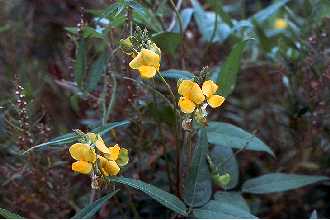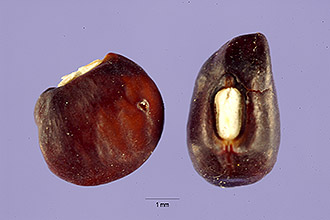Hairypod Cowpea
Scientific Name: Vigna luteola (Jacq.) Benth.

| General Information | |
|---|---|
| Usda Symbol | VILU3 |
| Group | Dicot |
| Life Cycle | Perennial |
| Growth Habits | Forb/herbVine, |
| Native Locations | VILU3 |
Plant Guide
Use a soil moisture meter to monitor the soil moisture where Hairypod Cowpea is planted.
Fact Sheet
Alternate Names
hairypod cowpea, deer pea, Vigna repens
Uses
Wildlife: Wild cowpea (Vigna luteola) is a good source of browse for white-tailed deer. It can get quite bushy, and produce a lot of vegetation, making it a good plant for deer food plots. Ground feeding birds also enjoy the seeds.
Status
Please consult the PLANTS Web site and your State Department of Natural Resources for this plant’s current status (e.g. threatened or endangered species, state noxious status, and wetland indicator values).
Weediness
This plant may become weedy or invasive in some regions or habitats and may displace desirable vegetation if not properly managed. Please consult with your local NRCS Field Office, Cooperative Extension Service office, or state natural resource or agriculture department regarding its status and use. Weed information is also available from the PLANTS Web site at plants.usda.gov.
Description
Wild cowpea is a native, perennial, herbaceous vine that has trailing or twining branches that can grow to three feet in length or longer. Previously known by the scientific name Vigna repens, it has several common names including wild cowpea, hairypod cowpea, and deer pea. It is a member of the papilionoideae subfamily of the Fabaceae (legume) family. Wild cowpea has been known to nodulate. Wild cowpea is trifoliate with yellow zygomorphic (bilaterally symmetrical) flowers at the end of a long peduncle. It flowers from April to November in South Texas. It produces several fairly large seeds in pods 1-2 ½ inches long. Its vines often form dense tangles.
Adaptation and Distribution
Distribution , Use soil moisture sensors to measure the soil moisture of Hairypod Cowpea.
Distribution
Wild cowpea grows along coastal regions from tropical areas of Central and South America, north along the Gulf Coast states, and up the Atlantic seaboard as far north as North Carolina. It has also been found in Zimbabwe, Africa. In Texas, it is found in the coastal counties, inland to Hidalgo County, and along the barrier islands. Wild cowpea grows in wet pastures, along levees, elevated ridges, and on well-drained sites near along the edge of fresh-water to brackish swamps. It prefers moist to wet clay soils, although at the Kika de la Garza Plant Materials Center in Kingsville, Texas, we have been able to grow it dryland on Victoria Clay soil with good success. Wild cowpea will tolerate a wide range of salinities, ranging from 0 to 10 ppt.
Establishment
Wild cowpea can be easily propagated from seed or cuttings. Propagation from seed has ranged from 8-96 percent. Greenhouse germination tests conducted at the Kika de la Garza Plant Materials Center in 1998 and 1999 found that the variability may be due in part to accession differences. One wild cowpea accession consistently had better than 93% germination, while a second accession had less than 10%. Wild cowpea can be seeded directly or grown in cone-tainers in a greenhouse to produce transplants. Stutzenbaker (1999) recommends planting in a clean, weed-free seedbed, or broadcasting over lightly disturbed soils in the early spring. There are approximately 10,880 wild cowpea seeds per pound. Success with cuttings has been good. A cutting test conducted at the Kika de la Garza PMC in 1998 had an 80% survival rate when the cuttings were treated with a rooting hormone.
Management
Cowpea is extremely hardy and requires little management. At the Kika de la Garza Plant Materials Center, wild cowpea plantings have survived a winter freeze, extended periods of droughty conditions, defoliation by fall army worms and grasshoppers, and several trimmings by PMC staff. Further, the plants still had good vegetative and seed production, and new seedlings were present in the plot. Larry Allain USDI GS NWRC @ PLANTS Stutzenbaker (1999) notes that wild cow pea can endure livestock grazing, periodic burning, and occasional floods. For additional assistance regarding the production and establishment of wild cow pea, please contact the Plant Material Center at (361) 595-1313.

